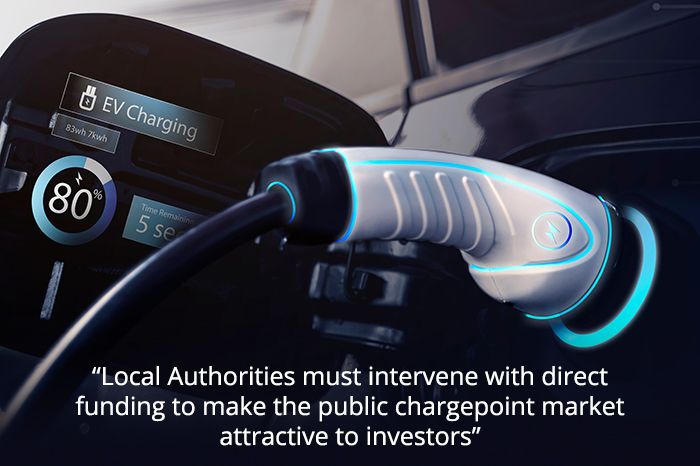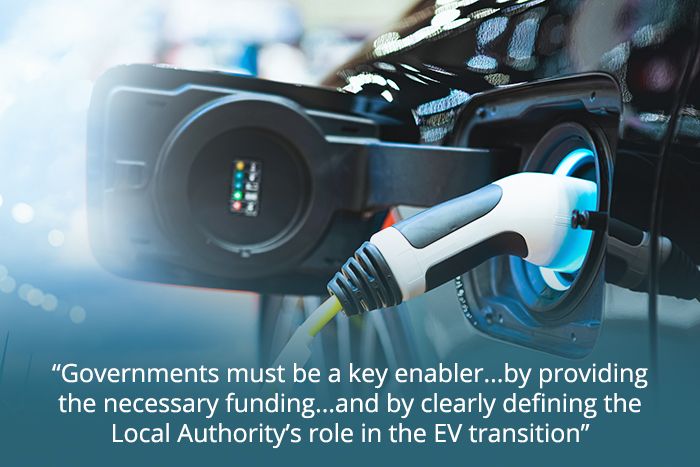The Climate Action Plan 2021 and the 2021 updated National Development Plan both outline a clear target of having nearly one million electric vehicles (‘EVs’) on Ireland’s roads by 2030. Kieran Collins of our Corporate Finance team explores how this could be achieved.
Currently there are approximately 41,000 EVs on Irish roads and 1,350 public chargepoints. The EV industry faces the age-old chicken and egg scenario – a lack of chargepoints can deter people from purchasing EVs, whilst a lack of take-up of EVs means there is no commercial model for investment in chargepoints.
Where to charge electric vehicles?
As your vehicle spends most of its time at home, this is where most of the charging will take place. This is the most convenient, cost efficient and sustainable way to charge your vehicle. This charging is typically on low voltage AC overnight when electricity is least in demand. Due to a large proportion of Ireland’s housing mix being made up of individual houses, more so than apartments, we have an advantage of being able to install and access the infrastructure at home, particularly as the majority of our houses have private off-street parking.
Fast and rapid chargepoints will also make up an essential part of the charging network, but these will be most prevalent at service stations on motorways or national roads and will play a key role in reducing range anxiety for longer journeys. Workplaces are currently, and will continue to, add EV chargepoints for employees, with shops and hotels doing similar, adding to the customer experience. So, what about our local amenities with parking spaces e.g. public buildings, parks, and on-street parking? The majority of these are owned and controlled by our Local Authorities (‘LAs’) and as such, our LAs have a key role to play in driving the increased adoption of EVs in Ireland.


What can Local Authorities do to help?
LAs can play an instrumental role in ensuring a ‘just transition’ by leading the way with the deployment of chargepoints for both residential units without access to private parking, as well as for the social housing stock that they own. The public chargepoint market is not currently commercially viable for private sector investment, so LAs must intervene with direct funding themselves to bring the market to a place that is attractive to investors.
Whilst they might not need to have a long-term role, LAs have an essential role to play in being the catalyst over the next few years. There are many other potential benefits from investing in EV charging infrastructure for LAs, over and above satisfying their statutory responsibility of providing equal opportunity. These include an additional revenue stream in the longer term, increased footfall at LA-owned facilities or attractions that receive an EV chargepoint, and environmental benefits of increased EV uptake being realised such as better air quality and reduced noise pollution in the region.
The Sustainable Energy Authority of Ireland (‘SEAI’) provides a grant to LAs which covers 75% of the capital costs associated with installing public chargepoints (capped at €5,000 per single chargepoint). However, the uptake by LAs has been very low. This is largely due to the four key challenges that local authorities face: determining the optimum business model, funding challenges, organisational challenges, and a lack of data to support decision making.
1. Determining the optimum business model
A key decision for LAs is the selection of the most appropriate business model. Should they pursue a full ‘own and operate’ model, or perhaps take on an external operator? Or should they seek private investment through a concession or lease agreement? Each of these options have their advantages and disadvantages.
However, there currently is no viable commercial model for private investment, so the kick start for public chargepoints must arise from public funding through some variation of an own and operate model. This model requires high levels of public funding and it results in the LA taking the complete share of utilisation risk, as well as it being resource intensive on LAs. Therefore, national government should look for opportunities to own and operate public chargepoints on a portfolio basis, or to procure one large operator nationally.
2. Funding challenges
Despite the SEAI grants available, one of the key challenges that LAs face in the roll-out of EV charging infrastructure is a lack of funding. UK case studies have demonstrated that the largest cost associated with installing on-street public chargepoints is often the grid connection cost, which is due to the need for trenching, traffic management, and sometimes road closures. In some circumstances, this can push the cost to the LA well above the €5,000 cap on the grant.
Then there are the O&M costs, and the pre-installation costs associated with developing an EV chargepoint strategy, determining locations, and procuring the installation. Therefore it is clear why the uptake on the SEAI grants is low – it’s still not enough funding to make it viable for LAs to invest. Government funding should not be restricted to capital expense, and instead also needs to be made available to incentivise LAs to take the first step and produce an EV charegepoint strategy which includes data-driven optimum locations for chargepoints in their area.
3. Organisational challenges
Which department in the local authority should be responsible for the roll-out of EV charging infrastructure? Most departments and employees are working at capacity so there is unlikely to be an overly enthusiastic showing of hands to take ownership in this area. Very few LAs have a dedicated team for delivering EV charging infrastructure.
As outlined above, if LAs can get the necessary public funding to proceed with some variation of an own and operate model, this will be resource intensive. LAs should work together by pooling their resources regionally, which would enable the sharing of expertise, and the pooling of procurements. Good governance and reporting structures set up from the outset would ensure that the necessary cross-functional collaboration occurs.
4. Lack of data to support decision making
The first step for a local authority embarking on a journey of EV chargepoint roll out is to determine the optimum locations for public chargepoints. To be able to do that most effectively, it needs to be armed with good national and regional data on both the supply and demand sides of the problem to inform the geo-spatial decision-making process. LAs should not do this in silos, as EV users will not consider LA borders when deciding which chargepoint to use.
The LA’s chargepoint location strategy must align with that of the neighbouring LA’s, again demonstrating the value of a regional or even national pool of resources to address the need for public chargepoints holistically. With the right data located in one database, combined with good criteria for prioritisation, a LA’s EV strategy will be well informed and give them the best chance of maximising the benefits that arise from their investment.


Towards a ‘Just Transition’
LAs must take action to ensure that they act as the catalyst for a ‘just transition’ to EVs within their region. However, they face a series of challenges that must be overcome; some within their control, and some that require intervention from parts of national government including DoT, DECC, and SEAI. In the recently published ‘Local Authority - Electrification of Fleet and EV Charging Guidance Document’, it was referenced that 76% of LAs in Ireland have not carried out an assessment of the EV needs in their region.
LAs must take this first step, and subsequently produce an EV strategy for their region. Governments must be a key enabler and not a blocker to this, by providing the necessary funding, by facilitating national collaboration, and by clearly defining the LA’s role in the EV transition. Investment in EV charging infrastructure can have wider benefits than just the decarbonisation of transport - it can also support the transition of the grid to a cleaner, more distributed generation model through the balancing of the supply and demand model.
Get in touch
The switch to electric vehicles will have implications for individuals and businesses across Ireland. If you have any queries on developing an EV strategy, please contact Kieran Collins of our Corporate Finance team. We'd be delighted to hear from you.
